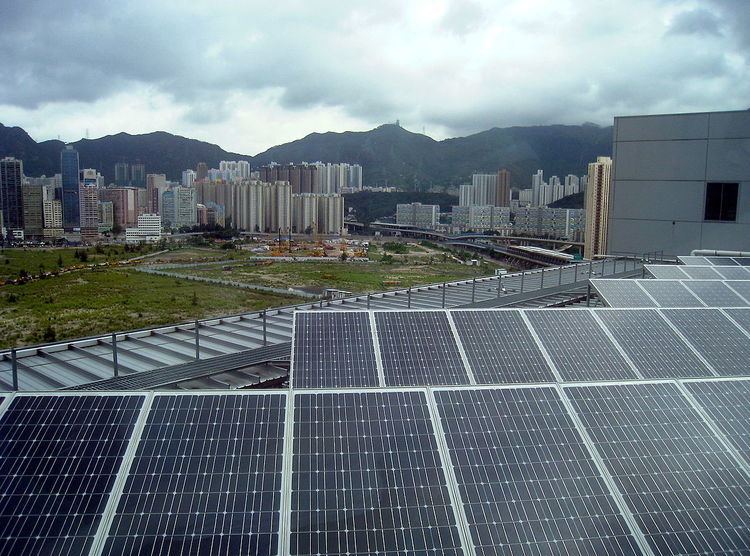 | ||
China is the world's largest market for both photovoltaics and solar thermal energy. Since 2013 China has been the world's leading installer of solar photovoltaics. Solar PV in China is a growing industry with over 400 companies. In 2015, China became the world's largest producer of photovoltaic power, narrowly surpassing Germany. By the end of 2016, total PV capacity had increased to over 77.4 GW. Solar water heating is also extensively implemented, with a total installed capacity of 290 GWth at the end of 2014, representing about 70% of world's total installed solar thermal capacity.
Contents
Solar photovoltaics
According to the European Photovoltaic Industry Association, the total installed capacity could grow to between 47 GW to 66 GW by 2017. Market research firm NPD Group forecasts that China will have over 100 GW of PV capacity by 2018.
In October 2015, China's National Energy Administration (NDRC) set an ambitious 23.1 GW target for 2015, upgrading its previous target of 17.8 GW from March 2015, which was already more than the entire global PV capacity installed in 2010.
As of October 2015, China planned to install 150 GW of solar power by 2020, an increase of 50 GW compared to the 2020-target announced in October 2014, when China planned to install 100 GW of solar power—along with 200 GW of wind, 350 GW of hydro and 58 GW of nuclear power.
In May 2014, the National Development and Reform Commission announced that the solar capacity target had been upped again, now to 70 GW by 2017.
Overall, China has consistently increased its annual and short term targets. However estimates, targets and actual deployment have differed substantially in the past: in 2013 and 2014, China was expected to continue to install 10 GW per year. In February 2014, China's NDRC upgraded its 2014 target from 10 GW to 14 GW (later adjusted to 13 GW) and ended up installing an estimated 10.6 GW due to shortcomings in the distributed PV sector.
In 2011, the 200 MW Huanghe Hydropower Golmud Solar Park was completed, the world's largest solar farm at the time. There are many other solar farms in Golmud, totaling 570 MW at the end of 2011, with another 500 MW expected in 2012. The Qinghai province, which contains Golmud, leads China in solar installations. Projects completed before September 30, 2012 receive 1.15 yuan ($0.18) per kWh. In May 2011, the National People's Congress (NPC) set 5 GW as an official minimum PV target for 2015, with a longer-term target of 20–30 GW by 2020.
In 2009, Wang Zhongying, a Commission official, mentioned at a solar energy conference in Shanghai that the plan might be exceeded several-fold, with the installed capacity possibly reaching as much as 10 GW by 2020.
According to plans unveiled by the National Development and Reform Commission in 2007, the country's installed solar capacity was to grow to 1,800 MW by 2020.
Manufacturers
China has been the world's largest manufacturer of solar panels since 2008 and, since 2011, has produced the majority of global photovoltaics on an annualized basis. Industry projections estimate that, by the end of 2017, China will have enough manufacturing capacity to produce 51 GW of photovoltaics per year, an amount over twice as large as 2010's global production of 24 GW.
The industry is dominated by several major manufacturers. They include CHINT Group Corporation, JA Solar Holdings, Jinniu Energy, Suntech Power, Yingli, China Sunergy and Hanwha SolarOne. Large debt challenges several manufacturers.
Concentrated solar power
The 12th five-year plan, for 2011 to 2015, calls for installing 1,000 MW by 2015, and 3,000 MW of concentrated solar power plants by 2020. Plants either being planned or under construction:
Solar water heating
China is the first country for solar water heating capacity in the world, with 290 GWth in operation at the end of 2014, accounting for about 70% of the total world capacity. In terms of capacity per unit of population, China comes 7th in the world with 213 kWth per 1,000 people. Most of the installed capacity (92%) was evacuated tube water heaters.
Controversy
China is a large producer of polysilicon, for use in first generation solar cells around the world. A byproduct of the process is poisonous silicon tetrachloride, which is normally processed and recycled at a higher cost in the developed world, but often dumped by Chinese green startups, With proper recycling the polysilicon would cost $84,500 per tonne, but the Chinese companies are making it at $21,000 to $56,000 a ton.
Zhejiang Jinko Solar Co., Ltd., founded in 2006 as a subsidiary of Hong Kong-invested JinkoSolar Holding Co, Ltd (NYSE Stock Code: JKS), produces solar panel photovoltaic cells and wafers. It employs more than 10,000 professionals in two factories in east China and has offshore offices and warehouse in the United States and Europe, according to the company website (www.jinkosolar.com). On Thursday, 15 September 2011, more than 500 people from Hongxiao Village protested over the large-scale death of fish in a nearby river. Angry protesters stormed the factory compound, overturned eight company vehicles, and destroyed the offices before police came to disperse the crowd. Protests continued on the two following nights with reports of scuffle, officials said. Chen Hongming, a deputy head of Haining's environmental protection bureau, said the factory's waste disposal had failed the pollution tests since April. The environmental watchdog has warned the factory but it had not effectively controlled the pollution, Chen added.
